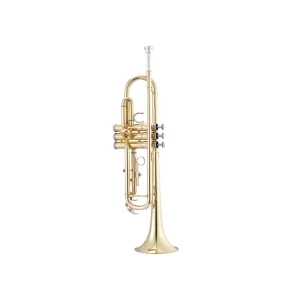Начните свое путешествие с трубы для начинающих может быть захватывающим, но и немного ошеломляющим. Труба - один из самых динамичных и узнаваемых представителей семейства духовых инструментов. Ее звук может заполнить концертный зал, прорваться сквозь марширующий оркестр или придать теплоту небольшому джазовому комбо.
В этом руководстве вы узнаете, что делает трубу особенной, какие основные приемы должен знать каждый начинающий музыкант и как она вписывается в оркестр.
Является ли труба духовым инструментом?

Да, это так. Труба относится к духовым, одной из двух основных категорий духовых инструментов. Другая - деревянные духовые.
Труба издает звук, когда игрок выдувает воздух через мундштук, вибрируя при этом губами. Ее корпус изготовлен из латуни или латунного сплава, что помогает создать ее фирменный яркий, властный тон. Именно поэтому ее прочно объединяют с другими духовыми инструментами, такими как тромбон, туба и валторна.
Советы новичкам по обучению Инструмент Труба
При обучении игре на трубе нужно не просто вдувать воздух в мундштук. Успех приходит благодаря сочетанию хорошей осанки, сильного контроля над дыханием и постоянной практики.
Осанка и дыхание
- Осанка: Встаньте или сядьте ровно, расслабив плечи. Возьмите трубу правой рукой - большой и указательный пальцы лежат на клапанах - и поддерживайте ее левой рукой под мундштуком. Колокол должен быть направлен немного вверх.
- Техника дыхания: Дышите диафрагмой, позволяя животу расширяться при вдохе. Выталкивайте воздух медленно и уверенно, когда играете. Избегайте поверхностного грудного дыхания, от которого можно быстро устать.
Амбушюр и сила губ
- Форма рта: Слегка сомкните губы, слегка сжав уголки, и сформируйте небольшое круглое отверстие в центре. Это позволит воздуху проходить через него, а губам - свободно вибрировать.
- Ежедневная практика: Начните с длинных тонов - удерживайте одну ноту так долго, как сможете. Ежедневно уделяя десять-пятнадцать минут упражнениям для губ, вы укрепите мышцы губ и улучшите контроль над ними.
Фингеринг и регулировка высоты тона
- Клапаны: Три клапана трубы можно комбинировать для создания различных нот. Например, нажатие на клапан 1 понижает тональность на целый тон, на клапан 2 - на полшага, а нажатие на оба клапана - еще ниже. Выучите схему и практикуйте плавные переходы.
- Тюнинг: Тюнер - ваш друг. Сильное давление воздуха может сделать ноту острой, а слабое - плоской. Регулируйте форму рта и поток воздуха, чтобы сохранить тональность.
Практический подход
- Стройте постепенно: Начните с простых гамм и легких песен, а затем переходите к сложным произведениям.
- Избегайте переигрывания: Новичкам следует ограничить занятия примерно 30 минутами, чтобы не напрягать губы. Если вы чувствуете дискомфорт, сделайте перерыв.
Основные характеристики трубы
Труба выделяется не только своим звучанием, но и гибкостью в использовании в различных музыкальных жанрах.
Тон и диапазон
- Тон: Яркий, смелый, способный проецировать на целый оркестр. При необходимости он также может играть теплые, нежные мелодии.
- Диапазон: Большинство труб играют от низкого F до высокого C и выше, хотя чаще всего используются средний и верхний диапазоны.
Структура и техника игры
- Структура: В комплект входит съемный мундштук, цилиндрическая трубка с тремя клапанами и расклепанный колокол. Такая настройка обеспечивает быстрый ход и плавные переходы между нотами.
- Техника: Трубы могут играть плавным легато, резким стаккато или широкими интервальными скачками. Приглушения, такие как прямые или чашечные, могут изменять тон для создания джазовых, классических или даже экспериментальных эффектов.
Роль трубы в симфоническом оркестре
Мелодия и гармония
- Ведущие мелодии: Трубы часто играют ведущую роль в героических или торжественных разделах. Во многих классических произведениях они задают настроение целым частям.
- Поддержка гармонии: Работая с рожками и тромбонами, трубы усиливают высшие гармоники и обогащают звуковую фактуру.
Ритм и драма
- Ритмический драйв: В маршах и церемониальной музыке труба добавляет сильные, четкие акценты, которые заряжают ансамбль энергией.
- Эмоциональный цвет: Будь то мягкий, таинственный пассаж или мощная кульминация, труба определяет эмоциональное направление произведения.
Труба в сравнении с другими духовыми инструментами
| Аспект | Труба | Валторна | Тромбон | Туба |
|---|---|---|---|---|
| Диапазон | Высокий, яркий и пронзительный | Среднечастотный диапазон, теплый и мягкий | Средне-низкий, богатый и торжественный | Низкий, глубокий и резонансный |
| Качество тона | Смелый и резкий | Лирические и округлые | Величественный, слегка растрепанный | Полная и основательная |
| Структура и стиль | 3 клапана для быстрого прохода | Колтюбинговые трубы, роторные клапаны | Заслонка для регулировки угла наклона | Самая большая трубка, глубокий звук |
| Оркестровая роль | Мелодичный свинец, яркая гармония | Гармонический мост | Поддержка гармонии и ритма | Басовая гармония и ритмическая основа |
| Общие стили | Классическая, джазовая, маршевая музыка | Камерная, оркестровая смесь | Джазовые, симфонические басовые линии | Духовой оркестр, оркестровый бас |
Основные выводы:
Труба - это как сопрано в духовом хоре: быстрое, четкое и выразительное. Валторна гармонично сочетается с ней, тромбоны придают глубину и ритм, а тубы составляют основу.
Как выбрать Хорошая труба для начинающих
Если вы только начинаете, выбирайте трубу, которая чувствует себя комфортно, дает чистый тон и не слишком тяжелая. Гладкие клапаны, прочная конструкция и сбалансированный вес являются ключевыми факторами. Вы можете посмотреть нашу подборку хороших труб для начинающих, чтобы найти модели, предназначенные для новых игроков.
Где найти Труба для продажи
Покупая у надежного источника, вы получаете качество и выгоду. Ознакомьтесь с нашим ассортиментом труб для продажи, чтобы получить оптовые возможности, оптовые цены и инструменты, проверенные на долговечность и производительность.
Заключительные размышления
Труба - это инструмент энергии, эмоций и точности. Начинающим музыкантам необходимо с самого начала выработать устойчивые привычки, которые сделают их путь более плодотворным. В оркестрах она привносит блеск в мелодии, мощь в кульминации и глубину в гармонии.
Свяжитесь с нами для оптовых заказов
Мы являемся ведущим оптовым дистрибьютором музыкальных инструментов в Китае, поставляющим качественные трубы и духовые инструменты по всему миру. Если вы музыкальная школа, дистрибьютор или бренд, который ищет надежные поставки и конкурентоспособные цены, свяжитесь с нами сегодня, чтобы обсудить ваш заказ.







